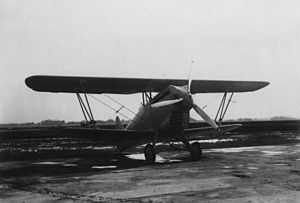Loading AI tools
Japanese fighter From Wikipedia, the free encyclopedia
The Kawasaki Ki-10 (九五式戦闘機, Kyūgo-shiki sentōki, Army Type 95 Fighter) was the last biplane fighter used by the Imperial Japanese Army, entering service in 1935. Built by Kawasaki Kōkūki Kōgyō K.K. for the Imperial Japanese Army, it saw combat service in Manchukuo and in North China during the early stages of the Second Sino-Japanese War. Its reporting name given by the Allies was "Perry".
| Ki-10 | |
|---|---|
 Ki-10 Model 1 | |
| General information | |
| Type | Fighter |
| National origin | Japan |
| Manufacturer | Kawasaki Kōkūki Kōgyō K.K. |
| Designer | |
| Status | Retired |
| Primary user | Imperial Japanese Army Air Force |
| Number built | 588 |
| History | |
| Introduction date | 1935 |
| First flight | March 1935 |
| Retired | 1942 |

The Ki-10 was designed by Japanese aeronautical engineer Takeo Doi,[1] who had succeeded Richard Vogt as chief designer for Kawasaki. The design was in response to a requirement issued by the Imperial Japanese Army for a new fighter, and was the winner of a competition against Nakajima's Ki-11. Although the low-wing monoplane offered by Nakajima was more advanced, the Army preferred the more maneuverable biplane offered by Kawasaki. In order to overcome the speed disadvantage the Kawasaki team used a metal three-blade propeller in the third prototype, while flush-head rivets were used in an attempt to reduce drag.[2]
The Kawasaki design had unequal-span biplane wings, braced by struts, and with upper-wing ailerons.[1] The structure was of all-metal construction, which was then fabric-covered. Armament consisted of two 7.7 mm (.303 in) Type 89 machine guns, synchronized to fire through the propeller. The initial production version was powered by a liquid-cooled 633 kW (850 hp) Kawasaki Ha9-IIa V-12.[citation needed]
The Ki-10 was deployed in Manchukuo (Manchuria) and in the initial campaigns of the Second Sino-Japanese War in northern China.[citation needed]
On September 21, 1937, Major Hiroshi Miwa, formerly hired as a military flight instructor for Zhang Xueliang's Fengtian Army air corps and well known in the Chinese military aviation circles of the time, commanded a flight of 7 Ki-10 fighters of the 1st Daitai-16th Hiko Rentai, on an escort of 14 Mitsubishi Ki-2 bombers to attack the city of Taiyuan where they encountered Chinese air force V-65C Corsairs and Curtiss Hawk IIs, shooting down a few, but Major Miwa himself was shot down and fatally wounded by Captain Chan Kee-Wong,[3] commander of the 28th Pursuit Squadron of the 5th Pursuit Group flying a Curtiss Hawk.[4]
By the time of the Nomonhan Incident (Battles of Khalkhin Gol) in 1939, the Ki-10 had become largely obsolete, and was being superseded by the Nakajima Ki-27.[5]
At the beginning of the Pacific War, the Ki-10 was retired to training and secondary missions, but later returned to front-line service, performing short-range patrol and reconnaissance missions in Japan proper and China in January–February 1942.[citation needed]

data from Japanese Aircraft of the Pacific War[6]
Total production: 588 units[6]

Data from Japanese Aircraft of the Pacific War [6]
General characteristics
Performance
Armament
Aircraft of comparable role, configuration, and era
Seamless Wikipedia browsing. On steroids.
Every time you click a link to Wikipedia, Wiktionary or Wikiquote in your browser's search results, it will show the modern Wikiwand interface.
Wikiwand extension is a five stars, simple, with minimum permission required to keep your browsing private, safe and transparent.